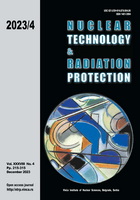
STUDIES ON SURFACE CONDENSATION FOR PASSIVE SAFETY SYSTEM IN LIGHT WATER REACTOR A Review

Vol.
XXXVIII, No. 4, Pp. 215-315
December 2023
UDC 621.039+614.876:504.06
ISSN 1451-3994
Pages: 215-234
Authors: Susyadi, Mulya Juarsa, Nandy Putra, and Raldi A. KoestoerAbstract
A system with a passive mechanism has been considered to have better trustworthiness because it does not require an external driving force to function. Several nuclear reactor designs have implemented this feature either fully or partially in their safety systems. Some of them combine boiling and condensation phenomena to deal with decay heat when an accident occurs. This paper reviews studies on condensation heat transfer in passive residual heat removal systems and passive containment cooling systems of light water-cooled reactors. The emphasis is on the applicability of acknowledged correlations for accident conditions and its development for a better model. In the explanation, the passive mechanism and type of condenser implemented in the system are first identified. Afterward, comparative formula assessment using test data, parametric studies using computer simulation, and new correlation development are discussed. The evaluation showed that the use of existing correlation needs tuning in the case of light water reactor passive safety system design. Besides, it was also suggested to take into account the geometric form of the condensation surface. Further research on helical shape is needed to assess the possibility of an integral reactor's steam generator changing role as a condenser during the loss of coolant accident that is followed by safety system failure.
Key words: condensation, safety system, heat removal, light water reactor, accident
FULL PAPER IN PDF FORMAT (2,08 MB)